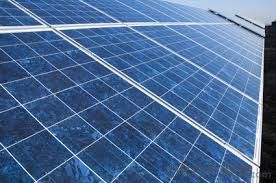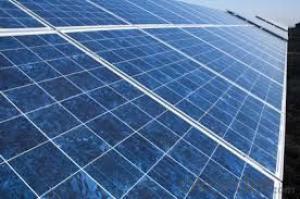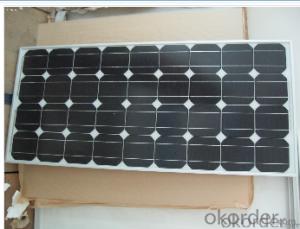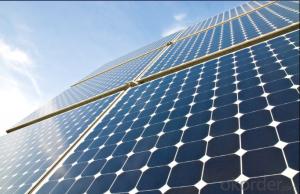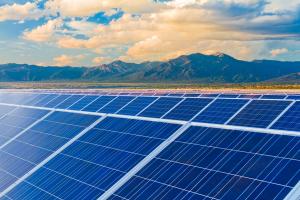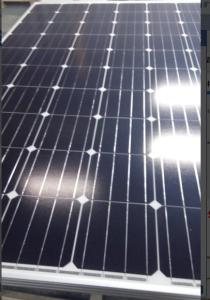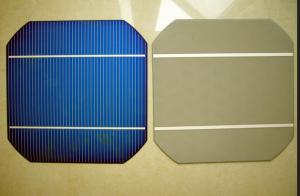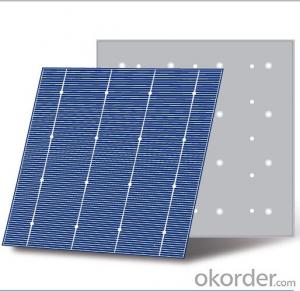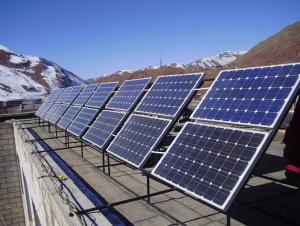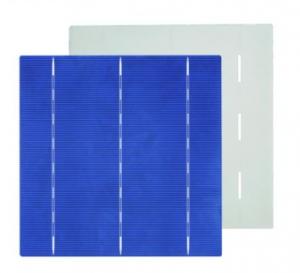Polycrystalline solar Panel with High Efficiency CNBM
- Loading Port:
- Qingdao
- Payment Terms:
- TT OR LC
- Min Order Qty:
- 10 set
- Supply Capability:
- 300000 set/month
OKorder Service Pledge
OKorder Financial Service
You Might Also Like
Polycrystalline Solar Modules
CNBM offers a range of small, medium and large polycrystalline solar modules, designed for a range of requirements.
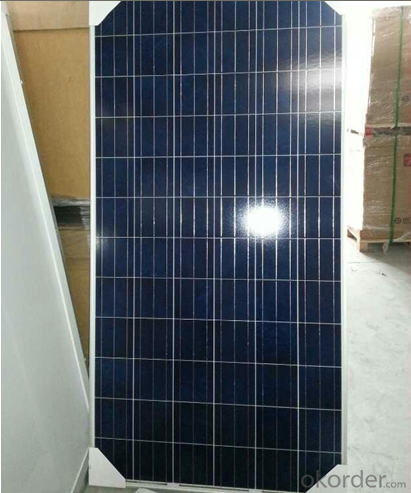

Specifications:
Tolerance | +/-3% |
Cell | Polycrystalline silicon solar cells (156 x 156mm) |
N0. of Cells | 60 (10 x 6) |
Dimension of Modules (mm) | 1650 x 990 x 40 |
Weight (kg) | 25.5 |
Limits:
Operating Temperature | -40~+85? |
Storage Temperature | -40~+85? |
Maximum System Voltage | 1000 VDC max. |
Hail Impact | Diameter of 28mm with impact speed |
Temperature and Coefficients:
NOCT | 48C+/-2? |
Voltage temperature coefficient (%/K) | -0.35 |
Current temperature coefficient (%/K) | 0.05 |
Power temperature coefficient (%/K) | -0.45 |
Characteristics:
Model: | SGM-200P | SGM-210P | SGM-220P |
Max-power voltage Vmp (V) | 29.2 | 29.4 | 29.41 |
Max-power current Imp (A) | 6.85 | 7.14 | 7.48 |
Open-circuit voltage Voc (V) | 36.5 | 36.69 | 36.9 |
Short-Circuit Current Isc (A) | 7.28 | 7.6 | 7.93 |
Max-power Pm(W) | 200 | 210 | 220 |
Model: | SGM-230P |
Max-power voltage Vmp (V) | 29.8 |
Max-power current Imp (A) | 7.72 |
Open-circuit voltage Voc (V) | 37.31 |
Short-Circuit Current Isc (A) | 8.19 |
Max-power Pm(W) | 230 |
STC: Irradiance 1000W/m2, module temperature 25?, AM-=1.5
Poly Crystalline Solar Panels Specifications Range
Maximum Power (Pm) | Dimension | Weight | Operating Voltage (Vmp) | Operating Current (Imp) | Open Circuit Voltage (Voc) | Short Circuit Current (Isc) |
0.45W | 140x80x10mm | 0.08kg | 3.3V | 150mA | 4.6V | 160mA |
1.0W | 162x140x10mm | 0.16kg | 7.5V | 150mA | 10.3V | 160mA |
4.5W | 269x251x23mm | 0.8kg | 16.5V | 0.27A | 20.5V | 0.3A |
10W | 420.1×268.9×22.6mm | 1.92kg | 17.5V | 0.58A | 20.5V | 0.6A |
20W | 425x502x50mm | 3.0kg | 16.8V | 1.19A | 21.0V | 1.29A |
30W | 593x502x22.6mm | 3.9kg | 16.8V | 1.78A | 21.0V | 1.94A |
40W | 655x537x50mm | 5.75kg | 17.3V | 2.31A | 22.1V | 2.54A |
50W | 839x537x50mm | 6.0kg | 17.5V | 2.9A | 21.8V | 3.17A |
65W | 1111x502x50mm | 7.2kg | 17.6V | 3.69A | 22.1V | 3.99A |
80W | 1204x537x50mm | 7.7kg | 17.6V | 4.55A | 22.1V | 4.8A |
- Q: What is the role of disconnect switches in solar cell systems?
- Disconnect switches in solar cell systems serve as a critical safety feature. Their role is to provide a means of disconnecting the solar panels from the rest of the system, including the inverter and electrical grid. This is essential during maintenance, repairs, or emergencies to ensure the safety of technicians and prevent electrical shocks or fires. Additionally, disconnect switches allow for isolation of the solar panels from the grid during power outages, preventing the flow of electricity into the grid, thus protecting utility workers from potential harm.
- Q: How to make solar cells in a scientific way?
- You can make it but you won't get too much energy out of that.
- Q: Can solar cells be used to power communication systems?
- Yes, solar cells can be used to power communication systems. Solar cells are capable of converting sunlight into electricity, which can then be used to power various electronic devices, including communication systems. This is particularly advantageous in remote or off-grid areas where it may be difficult or expensive to establish traditional power infrastructure. Additionally, solar-powered communication systems offer a sustainable and environmentally friendly alternative to relying solely on fossil fuels for energy.
- Q: Which one is better on the solar cells panel? The Monocrystal Solar Energy Cell or photovoltaic cell?
- The photovoltaic cell is better in collecting the sunlight, which means it will be more efficient when the sunlight is better.
- Q: Can solar cells be integrated into building materials?
- Yes, solar cells can be integrated into building materials. This is known as building-integrated photovoltaics (BIPV) and involves embedding solar cells into various components of a building, such as roofs, windows, or walls, to generate electricity. BIPV offers a dual purpose by combining the functionality of traditional building materials with renewable energy generation.
- Q: Can solar cells be used in security systems?
- Yes, solar cells can be used in security systems. Solar-powered security systems are increasingly popular as they provide a reliable and sustainable source of energy. Solar cells can power security cameras, motion sensors, alarms, and other components, allowing for remote monitoring and operation without relying on traditional power sources. Additionally, solar-powered security systems are often equipped with battery backup to ensure continuous operation even during periods of low sunlight or power outages.
- Q: What is the role of bypass diodes in solar cell systems?
- The role of bypass diodes in solar cell systems is to prevent the damage caused by shading or partial shading of the solar panels. These diodes provide an alternate path for the current to flow when some portions of the solar panels are shaded, ensuring that the rest of the panels can still generate electricity efficiently. By diverting the current around the shaded area, bypass diodes help to maintain the overall performance and reliability of the solar cell system.
- Q: Can solar cells be used in harsh climates?
- Yes, solar cells can be used in harsh climates. Solar cells are designed to withstand a wide range of environmental conditions, including extreme temperatures, high humidity, and strong winds. Additionally, advancements in solar technology have made solar panels more durable and resistant to damage from factors like snow, hail, and dust. However, it is important to consider the specific climate conditions and take necessary precautions to ensure the optimal functioning and longevity of solar cells in harsh climates.
- Q: Can solar cells be used in sports arenas?
- Yes, solar cells can be used in sports arenas. They can be installed on the rooftops or on surrounding areas of the arena to harness solar energy and generate electricity. This renewable energy source can help offset the energy consumption of the arena, making it more sustainable and reducing its carbon footprint. Additionally, solar cells can also provide shade and protection from weather elements, enhancing the overall experience for spectators.
- Q: Where can I buy solar cells on sale but still good quality ?
- Good solar cell sellers can get the best solar cells with highest quality as they have very strict quality control from material-during manufacturing-assemble-package; and they also check and test the structure strictly to ensure the whole solar mounting system can work under extreme weather condition;
Send your message to us
Polycrystalline solar Panel with High Efficiency CNBM
- Loading Port:
- Qingdao
- Payment Terms:
- TT OR LC
- Min Order Qty:
- 10 set
- Supply Capability:
- 300000 set/month
OKorder Service Pledge
OKorder Financial Service
Similar products
Hot products
Hot Searches
Related keywords


